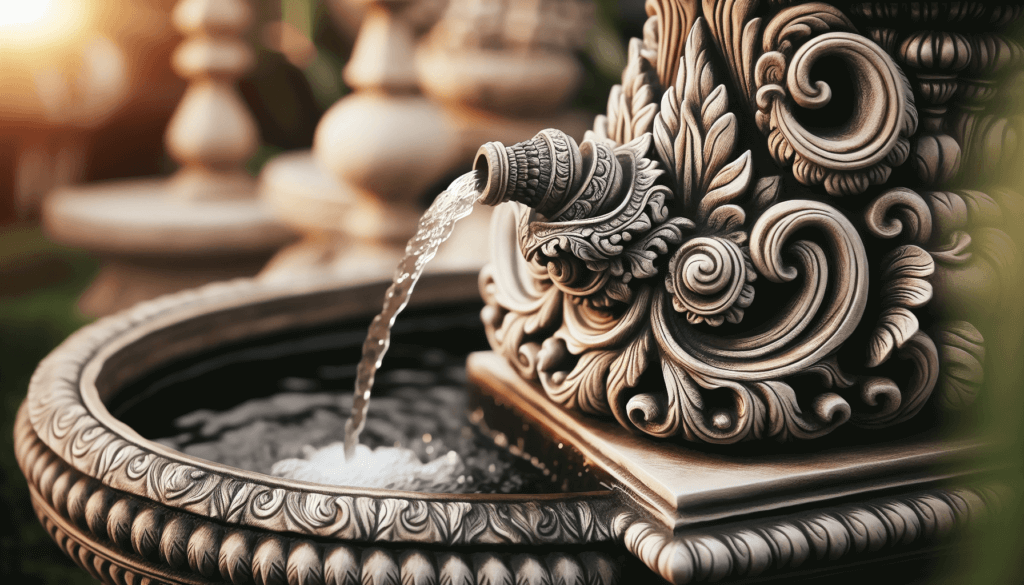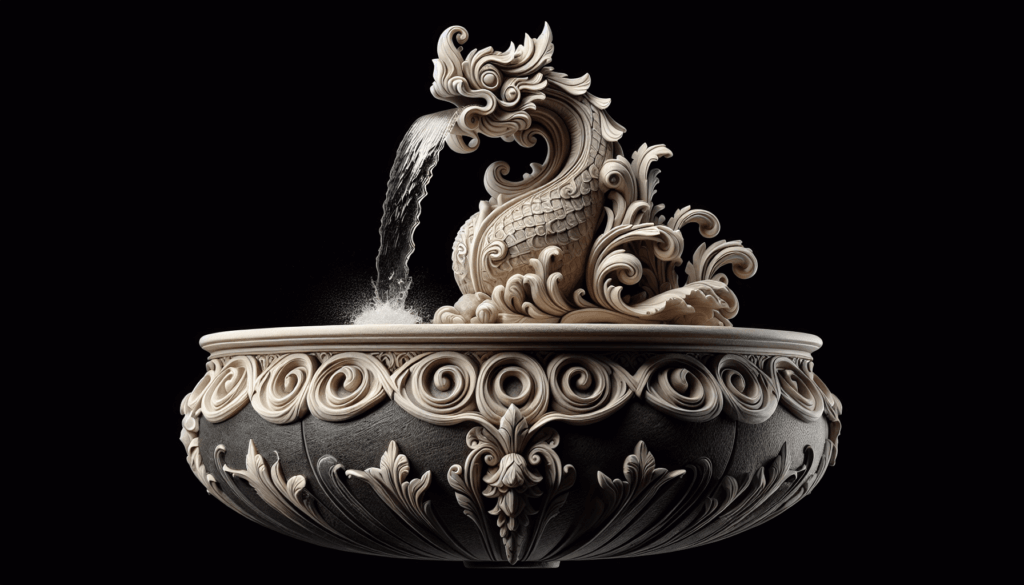Are you looking to add a touch of elegance and tranquility to your garden? Look no further than designing and building your own DIY garden fountain! From rustic stone water features to modern and minimalist designs, there are a variety of ways to create a personalized fountain that will enhance the beauty and serenity of your outdoor space. Whether you are a seasoned DIY enthusiast or a beginner looking for a new project, this article will guide you through the top ways to design and build your own garden fountain. So grab your tools and get ready to bring the soothing sound of flowing water to your backyard oasis!
1. Choose the Right Location
When designing and building a DIY garden fountain, one of the first steps is to choose the right location. Consider the available space in your garden and determine where the fountain will fit best. Take into account the size and dimensions of the fountain and ensure it does not overwhelm the area or obstruct other elements of your garden.
Assessing the sun exposure is also important when selecting a location for your fountain. Most fountains require sunlight to power any solar components and keep the water flowing properly. Make sure the chosen spot receives sufficient sunlight throughout the day to prevent any potential issues with the functionality of the fountain.
In addition to sunlight, evaluating the proximity to a water source is crucial. Your fountain will require a constant water supply, whether it comes from a nearby hose or an underground reservoir. Ensure that the chosen location is within reach of a water source to make the maintenance and upkeep of your fountain more convenient.
2. Determine the Fountain Style
Choosing the right fountain style is essential for creating the perfect ambiance in your garden. There are various styles to choose from, each with its own unique aesthetic. Consider the overall design theme of your garden and select a fountain style that complements it seamlessly.
A traditional tiered fountain is a classic choice that adds elegance and sophistication to any outdoor space. These fountains typically feature multiple tiers and cascading water, creating a serene and timeless atmosphere in your garden.
For a more contemporary and minimalist look, consider opting for a modern fountain style. These fountains feature clean lines and simple designs, perfect for those who prefer a more streamlined and understated aesthetic in their garden.
If you want to create a tranquil and peaceful ambiance, a Zen-inspired fountain is an ideal choice. These fountains often incorporate elements such as rocks, bamboo, and flowing water, evoking a sense of harmony and balance in your garden.

3. Select the Material
The choice of material for your DIY garden fountain will greatly impact its durability, appearance, and overall aesthetic. Consider the different options available and select the one that best suits your preferences and maintenance capabilities.
Stone or concrete fountains are popular choices due to their durability and timeless appeal. They can withstand harsh weather conditions and are less prone to damage. Stone or concrete fountains also add a touch of sophistication and elegance to your outdoor space.
Ceramic or pottery fountains offer a more delicate and artistic aesthetic. They come in a variety of intricate designs and vibrant colors, allowing you to add a unique and decorative element to your garden. However, it is important to note that ceramic or pottery fountains may require more careful handling and maintenance to prevent chip or cracks.
For those who prefer an eco-friendly and sustainable option, recycled materials can be an excellent choice. Fountains made from recycled materials, such as vintage containers or repurposed metal, not only help reduce waste but also add a rustic and eclectic charm to your garden.
4. Plan the Water Flow
Planning the water flow for your DIY garden fountain is crucial to ensure its functionality and visual appeal. Consider the following factors when mapping out the water flow system.
Firstly, decide on the water source for your fountain. This could be a nearby hose connection, an underground reservoir, or a rainwater harvesting system. Ensure that the water source is easily accessible and can provide a consistent supply of water for your fountain.
Next, choose an appropriate water pump that is capable of delivering the desired flow and pressure. The size and power of the pump will depend on the size of your fountain and the height to which the water needs to be pumped. Consult with a professional or refer to the manufacturer’s recommendations to select the right pump for your fountain.
Creating a water circuit is essential to ensure that water circulates properly throughout your fountain. This involves connecting the water pump to the basin and arranging the water pipes in a way that allows for a smooth and continuous flow. It is important to plan the circuit carefully to avoid any potential blockages or disruptions in the water flow.

5. Consider Lighting
Adding lighting to your DIY garden fountain can greatly enhance its visual appeal and create a captivating nighttime ambiance. There are several options to consider when it comes to lighting your fountain.
Installing underwater LED lights is a popular choice as they can create a mesmerizing effect, illuminating the water and highlighting the fountain structure. LED lights are energy-efficient and come in a variety of colors, allowing you to customize the lighting according to your preference.
Another option is to use solar-powered lighting, which eliminates the need for any wiring or electricity. Solar lights can be placed strategically around the fountain and automatically charge during the day to provide subtle illumination at night. This eco-friendly lighting option is not only cost-effective but also easy to install and maintain.
Incorporating spotlights in your garden can also be an effective way to highlight the fountain and its surrounding area. Spotlights can be positioned to create dramatic and focal points, drawing attention to the fountain and creating a stunning visual impact.
6. Create the Base/Foundation
Before constructing the actual fountain structure, it is essential to create a solid base or foundation. This ensures stability and longevity for your DIY garden fountain.
Start by digging a hole for the basin, ensuring that it is deep enough to accommodate the size of the basin and provide proper support. The hole should be level and free from any debris or obstructions that could affect the stability of the fountain.
Building a sturdy base is crucial to support the weight of the fountain and prevent any shifting or tilting. This can be achieved by using concrete blocks or bricks to create a solid and level surface for the fountain to rest on. Ensure that the base is strong enough to withstand the weight of the fountain and any additional decorative elements.
Once the base is constructed, it is important to level the ground surrounding the fountain. This not only improves the overall aesthetic but also helps prevent any water runoff or pooling that could affect the functionality of the fountain. Use a level to ensure that the ground is flat and even, making any necessary adjustments as needed.

7. Construct the Fountain Structure
Now that the foundation is ready, it’s time to construct the actual fountain structure. Follow these steps to ensure a successful assembly.
Start by assembling the tiered elements if you have chosen a traditional tiered fountain style. Follow the manufacturer’s instructions and carefully stack each tier, ensuring that they are securely attached to one another. Take your time to align the tiers properly and make any necessary adjustments for a symmetrical and balanced design.
Next, attach the water pipes and pump to the fountain structure. Depending on the design and complexity of your fountain, this step may require some planning and careful positioning of the pipes. Ensure that the water pipes are securely connected and are properly aligned to allow for a smooth water flow.
Once the fountain structure is assembled and the water pipes and pump are in place, it is important to secure the fountain to the base. This can be done using adhesive or waterproof sealant to ensure that the fountain remains stable and does not shift or wobble. Pay attention to any additional weight or decorative elements that may affect the stability and make adjustments accordingly.
8. Add Decorative Elements
To enhance the overall aesthetics of your DIY garden fountain, consider adding decorative elements that complement your chosen fountain style and personal taste. Here are a few ideas to get you started:
Incorporating plants and flowers around your fountain can liven up the space and add a touch of natural beauty. Choose plants that thrive in moist environments and are low maintenance, such as water lilies, tall grasses, or ferns. Arrange them strategically to create a harmonious and balanced composition.
Integrating decorative stones or pebbles around the fountain not only adds texture but also helps to prevent soil erosion and splashing. Use stones of various sizes and colors to create visual interest and complement the overall design of your garden. Ensure that the stones or pebbles are securely placed to avoid any potential hazards or disruptions to the water flow.
Including statues or sculptures can add a unique focal point and personal touch to your garden fountain. Choose statues that reflect your personal style and preferences, whether it’s a traditional Greek goddess, a whimsical animal, or a modern abstract sculpture. Position them strategically to enhance the visual impact and create a sense of depth and dimension.

9. Install the Water Feature
With the fountain structure assembled and the decorative elements in place, it’s time to install the water feature itself. Follow these steps to ensure a successful installation:
Start by connecting the water pump and pipes to the water source, whether it is a nearby hose or an underground reservoir. Ensure that all connections are secure and properly sealed to prevent any leaks or water wastage. Test the water flow to ensure that everything is functioning as intended.
Next, carefully fill the basin with water, ensuring that the water level is appropriate for the size and design of your fountain. Take into account any splashing or spray that may occur and adjust the water level accordingly. It is important to monitor the water level regularly and replenish it as needed to prevent any damage to the pump or fountain structure.
Once the water is flowing and the basin is filled, test the functionality of the fountain. Observe the water flow, check for any potential leaks, and listen for any unusual sounds. Adjust the water flow or make any necessary repairs or adjustments to ensure that the fountain is working properly.
10. Maintenance and Care
To keep your DIY garden fountain looking its best and functioning properly, regular maintenance and care are essential. Here are some important steps to follow:
Clean the fountain regularly to remove any dirt, debris, or algae that may accumulate over time. Use a soft brush or sponge and gentle cleansers to avoid damaging the fountain surface. Be sure to rinse thoroughly to remove any cleaning residue.
Monitor the water levels regularly to prevent any potential damage to the water pump. Ensure that the water level is maintained at an appropriate level and adjust as needed. If using a solar-powered fountain, ensure that the solar panels are clean and receive adequate sunlight for optimal performance.
During the winter months, it is important to winterize the fountain to protect it from freezing temperatures. Drain the water from the basin and disconnect the pump and any other water components. Store them in a warm and dry place to prevent any potential damage caused by freezing.
By following these top ways to design and build a DIY garden fountain, you can create a beautiful and tranquil oasis in your outdoor space. From choosing the right location to adding decorative elements, each step contributes to the overall aesthetic and functionality of your fountain. With regular maintenance and care, your DIY garden fountain will bring joy and serenity to your garden for years to come.



